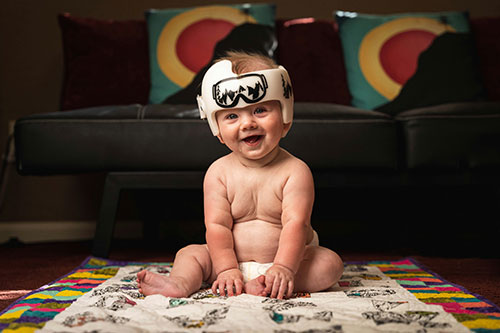Pediatric Care

Baby Helmet Therapy : Cranial Helmets
Helmet therapy (also called helmet orthosis or cranial helmet) is a treatment that’s prescribed to help mold the baby’s skull into shape. Babies skulls are made of many bony plates. The plates are joined by fiber-like pieces called sutures. Sutures help the skull protect the baby’s brain. They also allow some flexibility and space so that the brain can grow.
Cranial remodeling treatment is only effective if you have adequate control over the areas of bossing (bulging) and allow adequate room for growth in the flattened areas. That being said, it is paramount that the holding areas of the helmet match the exact anatomy of your child to prevent skin complications.
What conditions cause a baby to need a helmet?
- Positional skull deformity : Deformational plagiocephaly, brachycephaly and NICUcephaly are three conditions that cause a baby’s skull shape to change. They are caused by pressure on the skull when an infant spends a lot of time in one position.
- Craniosynostosis : This condition is caused when bony plates in the skull are abnormally fused together. As the brain grows in a child with craniosynostosis, the shape of the head becomes abnormal as the brain pushes out on the other parts of the skull. In some cases, the brain growth may be affected, as well. Craniosynostosis requires surgery and may be followed by helmet therapy. Some children with craniosynostosis may have other developmental needs.
- Deformational Plagiocephaly : The most common type of skull deformity in infants. Normally noticed by caregivers at about six to ten weeks of age. Characterized by an asymmetrical skull shape. Unilateral occipital flattening. Ear is positioned more anterior on the side of the occipital flattening. Forehead may be asymmetrical and is positioned more anterior on the side of the occipital flattening. Facial asymmetry may be present. May be accompanied by torticollis, limited neck range of motion, weakness and preferential head positioning.
- Deformational Brachycephaly : Central occipital flattening. Increased cranial vault height posteriorly. The head is excessively wide for its length. May be accompanied by a prominent, bossed forehead.
- Deformational Brachycephaly with Asymmetry : Combination of brachycephalic and plagiocephalic characteristics. The shape is disproportionately wide for its length and is also asymmetrical. May or may not include asymmetries to the forehead and facial structure.
- Deformational Scaphocephaly : Very elongated head shape that is excessively long for its width. May be accompanied by a prominent, bossed forehead. Deformational Scaphocephaly caused by extrinsic forces is uncommon although it is sometimes seen in premature infants who are often positioned side lying, such as NICU infants. Scaphocephaly caused by extrinsic positioning may be confused with sagittal synostosis, a more serious deformity that usually requires surgery to correct.

